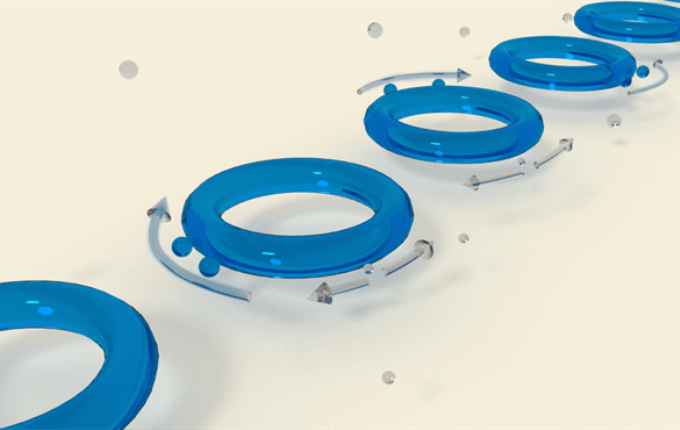Aug 14 2017
Currently, Electrical and Systems Engineers from the Washington University in St. Louis and their colleagues have demonstrated that when a third nanoscatterer is added to a photonics resonator, in addition to the existing two “tuning” nanoscatterers, the result is just exhilarating.
 Two light scatterers, represented by the blue spheres, are utilized to tune the sensors to exceptional points, at which light propagates in one direction. CREDIT: W. Chen and L. Yang.
Two light scatterers, represented by the blue spheres, are utilized to tune the sensors to exceptional points, at which light propagates in one direction. CREDIT: W. Chen and L. Yang.
Particularly, the already existing tuning nanoscatterers make the resonator to be in an “exceptional point”— a system’s distinctive state in which atypical phenomena might transpire. The third nanoscatterer disorders the entire system, and is similar to a horrible playground bully, in that the smaller its size, the more attention it acquires.
The team of Researchers from Washington University headed by Lan Yang, the Edwin H. & Florence G. Skinner Professor of Electrical & Systems Engineering has achieved significant progress in investigating and controlling light. The latest findings of the team related to sensing potential of microresonators can have positive effects in developing electronics, biomedical devices and biohazard detection devices.
It’s challenging to detect nanoscale objects, such as nanoparticles. If the object is very small, it introduces little perturbation to a sensing system. We utilize an unusual topological feature associated with exceptional points of a physical system to enhance the response of an optical sensor to very small perturbations, such as those introduced by nanoscale objects. The beauty of the exceptional point sensor is the smaller the perturbation, the larger the enhancement compared to a conventional sensor.
Lan Yang, the Edwin H. & Florence G. Skinner Professor of Electrical & Systems Engineering, Washington University
The sensor system developed by Yang and his colleagues can be classified as whispering gallery mode (WGM) resonators, which function similar to the very popular whispering gallery in St. Paul’s Cathedral in London. In the gallery, when a person utters a message to the wall on one side of the dome, a person on the other side can hear it. In contrast to the dome whose sweet spots or resonances are in the audible range, the resonation of the sensor occurs at frequencies of light.
The so-called ‘exceptional point’ endows a whispering-gallery sensor with exceptional performance for detecting nanoscale objects, surpassing that of conventional whispering-gallery sensors. Strikingly, the smaller the target object is, the better the performance of our new sensor will be.
Weijian Chen, an Electrical Engineering Doctoral Student in Yang’s lab
The WGM developed by Yang includes two complementary silica scatterers (or nanotips) which form a path on the toroid (or donut-shaped wire) for enabling the movement of millions of light packets, or photons. These devices adjust different parameters in the system to render the system operative. The team can adopt nanopositioning systems to move the scatterers and increase the size and also insert another medium, such as a virus particle, into the field to disturb the field and achieve an extraordinary condition.
In the latest experiments performed by the Researchers, the two “tuning” nanoscatterers make the resonator to attain the extraordinary condition. The third particle introduces a disturbance in the system from its extraordinary condition, resulting in frequency splitting. Due to the highly complex square-root topology closer to the extraordinary condition, the frequency-splitting, or the sensing signal, is mathematically depicted as the square root of the strength of perturbation. It is considerably greater than the value observed in conventional and typical point-sensing schemes by means of minute perturbations.
Yang and her colleagues are investigating the use of the extraordinary condition in photoacoustic imaging studies and other cases in which they try to achieve, “unconventional light transport modes,” stated Yang. “There should be many applications arising from that.”